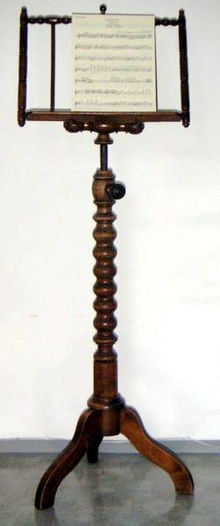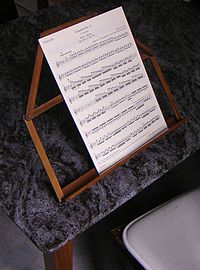
Back Статив (музика) Bulgarian Marc'h-levr Breton Faristol Catalan Notenpult German Pupitro Esperanto Pupitre French Pupitro IO Leggio Italian 譜面台 Japanese Notestativ NB
This article has multiple issues. Please help improve it or discuss these issues on the talk page. (Learn how and when to remove these template messages)
|

A music stand is a pedestal or elevated rack designed to hold sheets of music in position for reading.[1][2] Most music stands for orchestral, chamber music or solo orchestra-family instruments (violin, oboe, trumpet, etc.) can be raised or lowered to accommodate seated or standing performers, or performers of different heights. Many types of keyboard instruments have a built-in or removable music rack or stand where sheet music can be placed. Music stands enable musicians to read sheet music or scores while playing an instrument or conducting, as the stand leaves the hands free. For choirs, singers typically hold their music in a folder, and singers performing solo recitals or opera performances typically memorize the lyrics and melodies. Some singers use stands, such as lounge singers and wedding vocalists who have a repertoire of hundreds of songs, which makes remembering all of the verses difficult.

There is evidence of music stands from China as early as 200 BC. They did not appear in Europe until much later, as most musicians played from memory or improvised.[3] In the 16th century, playing music with a group in one's home became popular, and music was printed for amateurs' use. This music was typically laid down on a table or other flat surface in front of the instrumentalists.
Beginning in the 17th century, some amateur musicians used table-top music stands, which were the first kind of music stand in Europe. A few are still used today.

Gemeente Musea Delft; Collection Stedelijk Museum Het Prinsenhof, Delft
It is not until the 17th century that floor-standing music stands were developed in the West. Such music stands were common by 1730, at least in France.[4][5]
- ^ "Music stand". Dictionary.com. Retrieved 1 March 2016.
- ^ "Music Stand | Definition of Music Stand by Merriam-Webster". Merriam-webster.com. 2019-03-20. Retrieved 2019-03-25.
- ^ McGee, Timothy J., The Ceremonial Musicians of Late Medieval Florence, Bloomington & Indianapolis: Indiana University Press, 2009, p 227, 228
- ^ http://www.getty.edu/art/collection/objects/5361/ attributed-to-martin-carlin-music-stand-pupitre-french-about-1770-1775/?dz=0.6599,0.5221,1.80. [bare URL]
- ^ Francis Classe, “15th-16th C. Lectern/Music Stand,” accessed February 21, 2016, http://aands.org/raisedheels/ Other/Lectern/lectern.php.